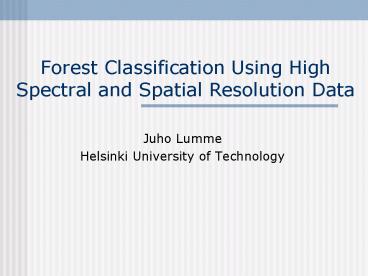Forest Classification Using High Spectral and Spatial Resolution Data
1 / 14
Title:
Forest Classification Using High Spectral and Spatial Resolution Data
Description:
Forest Classification Using High Spectral and Spatial Resolution Data. Juho Lumme ... Imaging spectrometer measures spectral and spatial properties ... –
Number of Views:204
Avg rating:3.0/5.0
Title: Forest Classification Using High Spectral and Spatial Resolution Data
1
Forest Classification Using High Spectral and
Spatial Resolution Data
- Juho Lumme
- Helsinki University of Technology
2
Introduction
- Forests are important natural resources for
Finland - They have financial, biological, social and
cultural significance - RS is an efficient tool for forest inventory
- Imaging spectrometer measures spectral and
spatial properties - Textural and spectral features are both used
- Data is analysed using separability measures and
classification
3
Test area
- Area is located in Lammi (Southern Finland)
- Contain
- Lakes
- Rural areas
- Cultivated fields
- Coniferous forests
- Deciduous forests
- Size 50 km long 2 km wide.
4
AISA data
- September 1999
- Six strips
- Pixel size 1 m
- 17 channels (visible light and infrared)
- Field surveys
- Geological Survey of Finland
- Over 250 training areas
5
Preliminary works Feature extraction
- Geometric and radiometric correction (METLA)
- NDVI and image texture were used to screen forest
areas - Principal Component Analysis
- Texture features...
6
Texture measures
- Measures were calculated using co-occurrence
matrix - Window sizes 25, 35, 45 pixels
- Distances 1, 3, 5 pixels
- 9 texture measures
- Homogeneity, contrast, dissimilarity, mean,
standard deviation, entropy, angular second
moment, correlation inverse difference
7
Forest Classes
- birch (seedling)
- birch (young/old)
- spruce (seedling)
- spruce (young)
- spruce (old)
- pine (young)
- pine (old)
8
Separability measures individual features
- Class separation was poor
- Best spectral channel 9
- Best texture measure mean
- Spruce and pine mixed
- Different age forest types mixed
9
Separability measures feature sets
- Both spectral and textural features
- All the classes were separated
10
Image classification
- Bayes Perceptron Neural Network
- Several different feature sets
11
Image classification
1 Bayes classification with principal component
channels 2 Bayes classification with principal
component channels and texture features 3 Bayes
classification with three original image
channels, principal component channels, NDVI and
texture features 4 Neural network
classification with all original image channels
and texture features
- Seedling classes were rather uncertain
- Bayes led to better results
12
Conclusion
- Different age forest stands are hard to
distinguish - Both spectral and textural features are useful on
forest airborne hyperspectral data analysis - The results of this study are able to generalize
to the satellite case
13
Grey level co-occurrence matrix
- A GLCM is a two-dimensional histogram of grey
levels for a pair of pixels which are separated
by a fixed spatial relationship (PCI, Geomatica)
14
GLCM Texture analysis






























